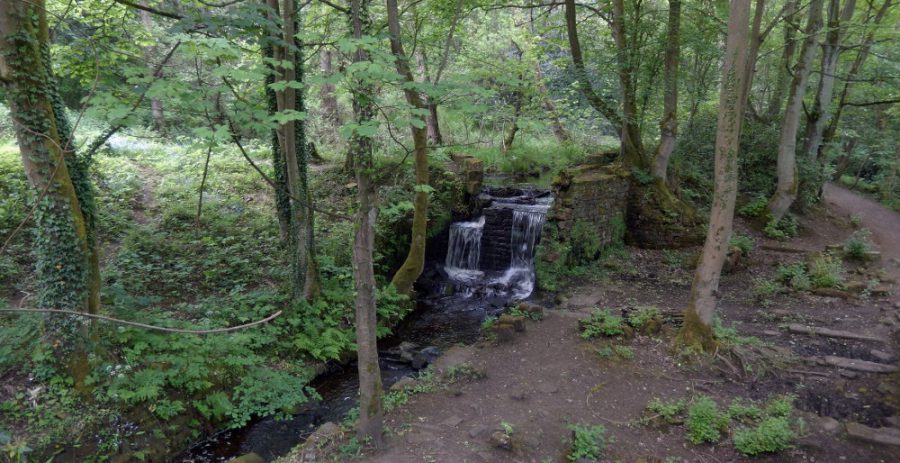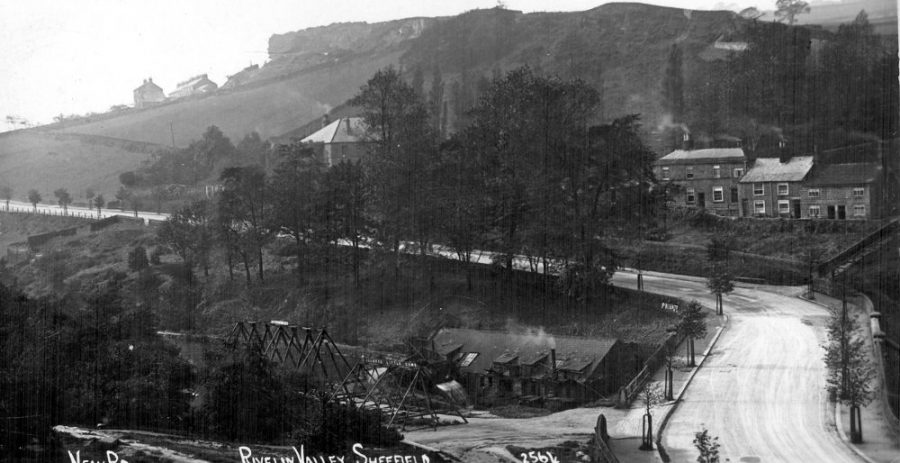
Introduction
Established by 1749, Upper Cut Wheel was used for cutlery grinding until the 1930s. In the early 20th century visitors could hire rowing boats and enjoy the swing boats located here.
The Upper Cut mill dam was very long and narrow, but the outline is now mostly obscured. A stream flows from the weir along the head goit and along the northern retaining wall of the mill dam. The water cascades into the remains of the wheel pit, and then under Rivelin Valley Road and into Nether Cut mill dam.
A good view of the site can be seen by looking over the railings alongside Rivelin Valley Road.
History (C. 1749–1930s)
Also known as: New Wheel, Upper Cutford Wheel.
Main trades: Cutlery grinding, rowing boat hire, swing boats.

There is some confusion in the records between the Upper Cut and Nether Cut Wheels, but the first record for Upper Cut appears to be in a lease of 1749. In 1794 the wheel pit had a 13 ft 8 in (c. 4 m) fall of water; there were eight trows and 13 men employed. In 1818 it was rented by Bradshaw & Co for £7 per annum. Like Nether Cut, the Wheel was involved in a rattening* case in 1874. Work ceased here around 1930.

The photograph below show the mill dam and building in the early 20th century. Around that time, rowing boats were available for hire and the many visitors could also enjoy rides on the swing boats located here.
What's there now?
About 200 m upstream, a small bridge marks the inlet to the head goit at the low stone weir, which is deteriorating at the south-east end. There is a roller assembly on the head goit lintel above a modern shuttle gate.
The footpath runs along the bank between the head goit and the river. Water flows into the long and thin mill dam, now made even narrower due to slippage from the hillside above.

Water overflows directly from the dam into the wheel pit – some of the better remains of a wheel pit in the valley exist here. Between the wheel pit and the river you can still make out the footings and walls of the mill buildings, partly obscured now under the path and steps up to Rivelin Valley Road.
The tail goit goes under Rivelin Valley Road through a large stone archway into the Nether Cut mill dam. Upper Cut and Nether Cut were also linked via an overflow channel, which also appears to be culverted under the road.
The tumbled-down walls on the north side of the river are a reminder of the old allotments, and stones along the edge of the river are the remains of an old trackway.

Nature and wildlife at Upper Cut Wheel
A stream now flows along the head goit and the northern retaining wall of the mill dam, and is quite high above the river. Look out for dippers, bobbing on the stones in the shallow water.

The long-narrow mill dam is now mostly obscured – partly by vegetation, but also partially infilled due to slippage from the hillside above. There is a small patch of aquatic vegetation, including Yellow Flag Iris, near the overflow.
The wall alongside the wheel pit provides an ideal damp habitat for ferns, mosses and liverworts, including the Great Scented Liverwort.

